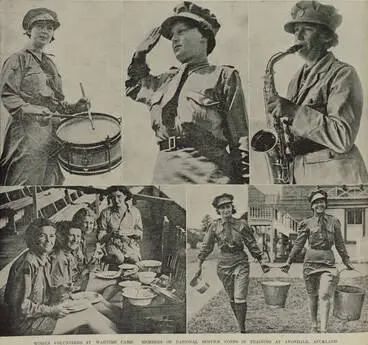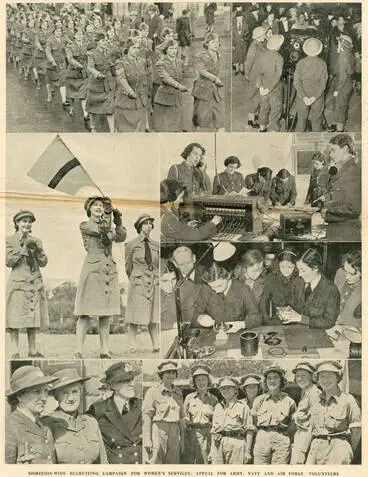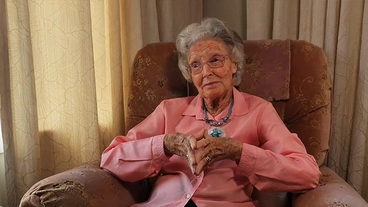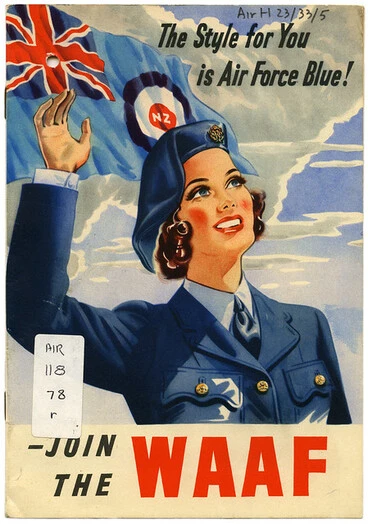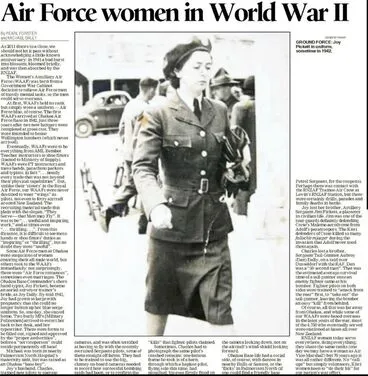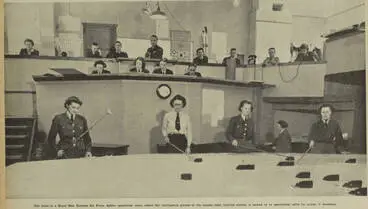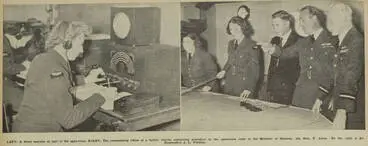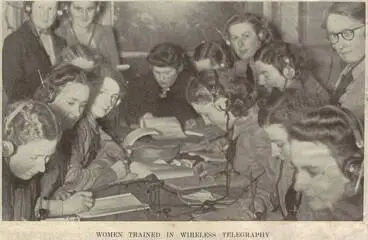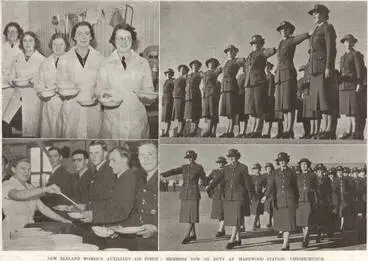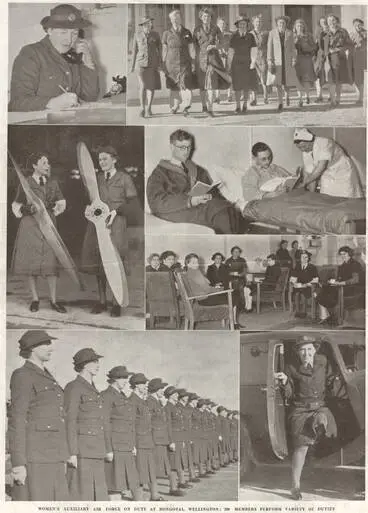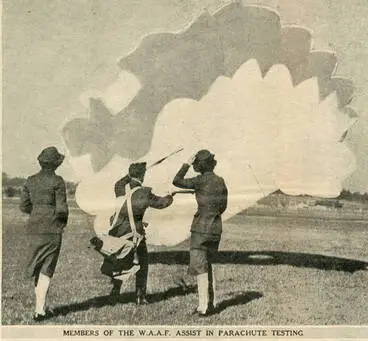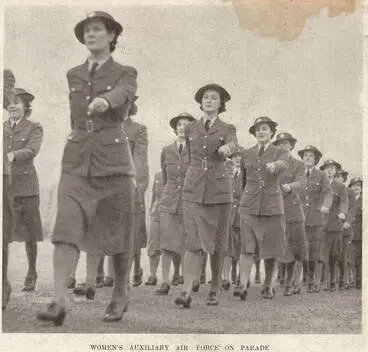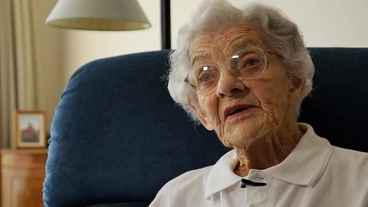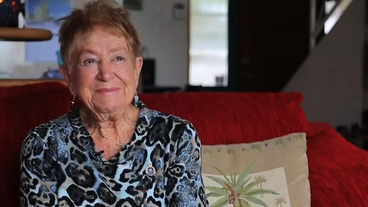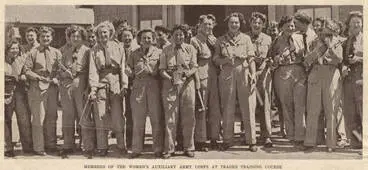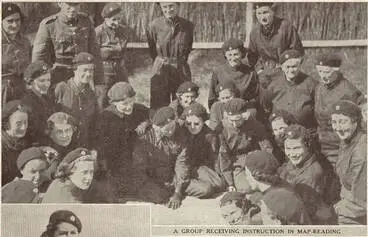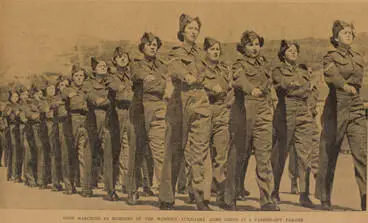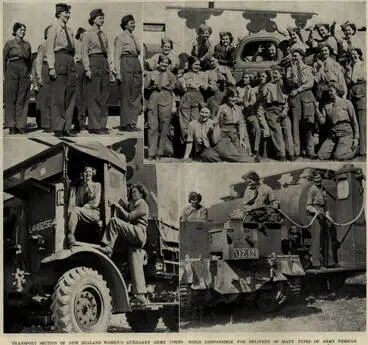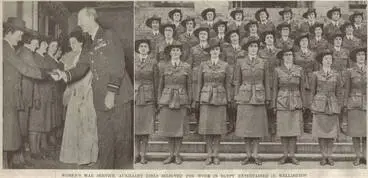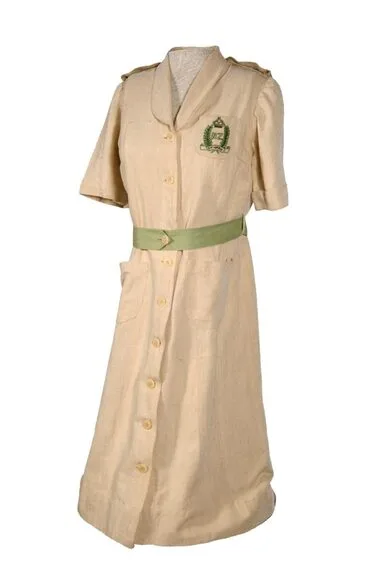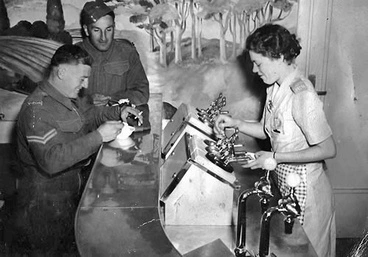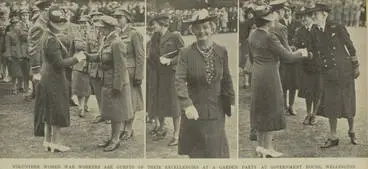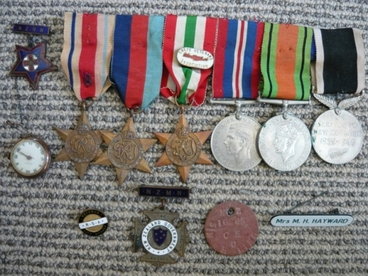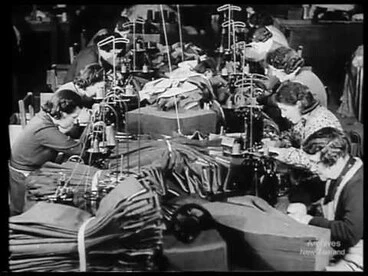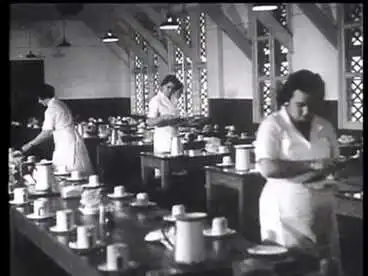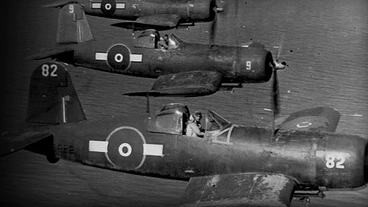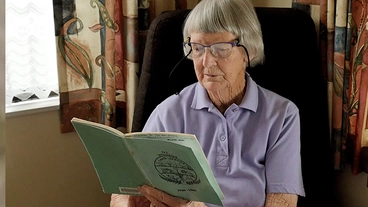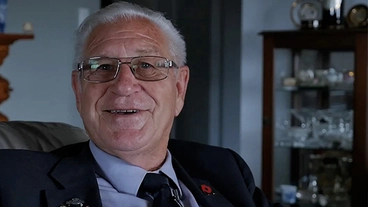Women in workforce during WWII
A DigitalNZ Story by Zokoroa
Women working at 'men's' work during WWII in the homefront and overseas was a turning point in social equality.
Women, WWII, War World War 2, World War Two, occupations, work, jobs, equality, equal pay, land girls, homefront, military, army, navy, air force
During World War II women worked at 'men's' work to free up over 200,000 men to serve in the armed forces. They were encouraged to "do their bit" for the war effort - from manufacturing uniforms, equipment and weaponry; to working in factories and on farms, trams and the railways. They also served in the Air Force, Army and Navy in Europe and the Pacific. Whereas in September 1939 the female labour force was estimated at 180,000, by December 1943 there were 228,000 women employed at the homefront and 8000 in the armed forces. (See NZETC: No easy victory)
Woman driving a post and telegraph truck during World War II
Alexander Turnbull Library
WAR years: SOCIAL TURNING POINT
New occupations for women:
The war years were a social turning point for women in the work force. There were opportunities for new forms of employment traditionally carried out by men. Prior to the war, women's occupations included shop assistants, clerical work, nursing, school teaching and "domestic work". With the outbreak of war, they were also needed to carry out work in the farming, manufacturing, engineering, weaponry and transport industries; and serve in the military.
Woman operating a metal lathe during World War II
Alexander Turnbull Library
Margaret Dickinson welding
Alexander Turnbull Library
MARRIED WOMEN WORKING:
On becoming married, women had tended to leave the workforce. With the increasing demand for female labour to fill job vacancies left by servicemen, changes took place in traditional attitudes to the family and domestic life. Initially married women were exempted from being required to work, but by the end of 1943 they were required to register. Only mothers with children under the age of 16 were exempt unless they had access to childcare. Between 1936 and 1945, the proportion of married women in paid employment rose from 8.5 to 17.2 percent. (See NZETC: No easy victory)
beginnings of equal pay:
Women were invariably paid less than men. In October 1942 minimum weekly rates were fixed at £5 10s for men and £2 17s 6d for women. However, the question of equal working conditions was raised in some occupations, leading women to become actively involved in employee organisations. For example, in 1942 the New Zealand National Tramways Union won equal pay for women who had been appointed as tram conductors following a shortage of men. (See NZHistory)
Tram conductors
From 1942 women were employed as tram conductors and the employers wanted to pay lower wages than men.
Auckland Libraries
1st union to win equal pay
The New Zealand National Tramways Union (formed in 1939) argued for and won equal pay for equal work in 1942.
Alexander Turnbull Library
Woman tram driver placing trolley pole on wire
Alexander Turnbull Library
Homefront
VoluNteer Workers:
The Women’s War Service Auxiliary (WWSA) was established in August 1940 to co-ordinate NZ women volunteering for work. Its main function was to co-ordinate nationally the activities of women’s organisations and to work in collaboration with the Department of National Service.
Women's War Service Auxiliary (WWSA)
Established in August 1940 to co-ordinate activities carried out by women for the war effort.
Auckland War Memorial Museum Tāmaki Paenga Hira
Duties included: Signallers, Transport, Canteen, Ambulance, Clerical, Camouflage net-making & Anti-aircraft handling.
Register of Duties, W.W.S.A., Mataura Branch
Mataura Museum
The Auxiliary fielded enquiries and kept a register to organise volunteer groups.
The women's part: inquiries regarding auxiliary service
Auckland Libraries
Women factory workers transported by bus to work.
[A bus load of women factory workers]
Auckland War Memorial Museum Tāmaki Paenga Hira
'MAN-POWERED' workers: Jan 1942-June 1946:
In January 1942, the Government passed the Industrial Man-power Regulations whereby men and women could be directed where they were needed in essential industries and occupations. Men and women were required to register at the local Man-power Office, which was a branch of the National Service Department. By the end of March 1944, 147,000 women were registered for employment. The Government continued to 'manpower" people into jobs until June 1946. (See NZHistory).
Industrial Man-power Regulations, 1942
Men and women were required to register at the local Man-power Office of the National Service Dept.
Auckland War Memorial Museum Tāmaki Paenga Hira
147,000 women registered in essential industries by end of March 1944
Included: munitions, power supply, shipping, food processing, sawmilling, mines, railways, clothing, footwear. hospitals
DigitalNZ
Age criteria for women to sign up (married women exempted until end 1943)
Aged 20-21 (1942); 19-21 (Feb 1943); 19-40 (1944). Exempted if had children under 16 yrs, unless had childcare.
Auckland Libraries
Range of HOMEFRONT occupations
There were more women employed in jobs "where previously there had been few or none, such as in the Public Service, banks, Post and Telegraph, railways, trams, engineering, canneries, farms, flax and rubber mills and driving work". In addition, women acted as "substitutes for men—on milk rounds, as hotel porters, zoo attendants, on domestic meter reading, trucking fruit and vegetables to city markets, scientific work, joinery, brick works, delivering coal, announcing trains at stations, and one even became radio officer on the Cook Strait ferry Tamahine". (See NZETC: The Home front, V2).
Military uniforms, equipment & Weaponry:
Sewing army uniforms
Women making army uniforms, Cathie and Sons Ltd, Wellington - Photograph taken by Government Film Studios
Alexander Turnbull Library
Working on military helmets
Two unidentified women working on military helmets during World War 2
Alexander Turnbull Library
Assembling mortar shells
Women assembling parts for trench mortar shells, Swan Electric Co Ltd, Dixon Street, Wellington
Alexander Turnbull Library
Making camouflage nets
Group of Women's War Service Auxiliary making camouflage nets WW2
Dunedin Public Libraries
FacTories; Industrial:
A description of working life in a clothing factories is recounted in this Otago Daily Times article "When it was all women's work (24 April 2008)
Measuring screw gauges in the metrology room at the Dominion Physical Laboratory
Anthea Abercrombie working in the Dominion Physical Laboratory in Gracefield, Lower Hutt, Wellington
Alexander Turnbull Library
Working on a 1937 Chevrolet car
Unidentified member of the New Zealand women's services working on a car during World War 2
Alexander Turnbull Library
Food Production industries:
Canning peaches at Watties factory
Women canning peaches at the Wattie's factory in Hastings
Alexander Turnbull Library
Food dehydration plant in Pukekohe
Women working in a food dehydration plant in Pukekohe during World War II
Alexander Turnbull Library
Interior of food dehydration plant
Interior of a food dehydration plant in Pukekohe during World War II
Alexander Turnbull Library
Freezing works
Female freezing works employees outside the works in Otahuhu, Auckland
Alexander Turnbull Library
Making wooden cheese crates
Creator unknown : Photograph of women making wooden ends for cheese crates, Waipa State Forest box factory, Rotorua
Alexander Turnbull Library
Postal, railways, tramways, Ferries:
Delivering mail bags for Post and Telegraph Dpt
Women from the Post and Telegraph Department lifting mail bags - Photograph taken by Government Film Studios
Alexander Turnbull Library
Working on tramway tracks
Women working for Wellington Tramways - Photograph taken by C P S Boyer
Alexander Turnbull Library
Radio officer on the Cook Strait ferry Tamahine.
Cook Strait ferry steamer passes through Tory Channel, entrance to Marlborough Sounds
Auckland Libraries
Women porters replaced men on railways
Women porters replace men in New Zealand railway service: training course at Wellington Station
Auckland Libraries
Hostesses, NZ Railways.
Auckland War Memorial Museum Tāmaki Paenga Hira
Clerical / Office:
Office signs read: "Important. Black-out restrictions. No lights are to be switched on in Front Offices after dark."
Office and workers, during World War II
Alexander Turnbull Library
Y.W.C.A. Wartime Business Office
Y.W.C.A. Wartime Business Office, Auckland
Auckland War Memorial Museum Tāmaki Paenga Hira
Women's Land Service:
The Women's Land Service was the largest of the women's war services in NZ during WWII - 2,711 land girls were placed on farms, and hundreds more served unofficially on family farms, totalling 2,963 different farms (see Te Papa).
Women! over 17 years of age. For a healthy, vital war job, join the Women's Land Service. [1942-1943].
Alexander Turnbull Library
Land girls Carol Sladden and June Matthews, Porangahau, Hawke's Bay
Alexander Turnbull Library
Land Girls
Radio New Zealand
Ear marking a lamb
June Matthews, of the Women's Land Service, helping Bob McKenzie to ear mark a lamb
Alexander Turnbull Library
Handling shorn wool
[Four women in paddock holding piles of sheared wool]
Auckland War Memorial Museum Tāmaki Paenga Hira
Breakfasting on sheep farm
Land girls having breakfast, Mangaorapa, Hawke's Bay
Alexander Turnbull Library
Churning butter
Alexander Turnbull Library
Haymaking team
Women working on Farm During World War II, Palmerston North
Palmerston North City Library
Riding horse-drawn hay baler
[Woman riding horse drawn hay baler]
Auckland War Memorial Museum Tāmaki Paenga Hira
Linen flax
Driving tractor when working with linen flax
Alexander Turnbull Library
Sawing manuka wood
Carol Sladden and June Matthews, of the Women's Land Service, helping farmer Bob McKenzie to saw manuka firewood
Alexander Turnbull Library
Vegetable gardening
Alexander Turnbull Library
Women's Service League bagging potatoes. (Each paid 1s 3d an hour for a parcel fund for servicemen overseas.)
Women's Service League bagging potatoes, Opiki
Palmerston North City Library
Land Service Handbook of Information
New Zealand Women’s Land Service Handbook of Information
Palmerston North City Library
Land Girls
Radio New Zealand
Red Cross & emergency services:
New Zealand Red Cross and the Order of St John created the Joint Council to provide services during World War II. Between 1941 and 1946, 1,139,624 food and clothing parcels were packed by volunteers and sent overseas. The Red Cross also staffed Medical Units and provided supplies to three hospital ships - the “Maunganui”, “Oranje” and the “Somersetshire”. (See New Z ealand Red Cross.)
Red Cross nurses marching in procession, Wellington
Alexander Turnbull Library
Auckland Star (Photographer) : Women Red Cross transport drivers, Auckland
Alexander Turnbull Library
Palmerston North Red Cross Transport Workers
Palmerston North City Library
NZ Voluntary Aid Detachment (VAD) nurses at maternity home
Voluntary Aid Detachment nurses holding infants at the Alexandra Maternity Home in Wellington
Alexander Turnbull Library
Members of the Order of St John demonstrating first aid.
Members of the Order of St John demonstrating first aid
Alexander Turnbull Library
Four unidentified Maori nurses from the St John's voluntary ambulance organisation
Alexander Turnbull Library
Fire brigade & Ambulance
Crown Studio (Gore), fl 1940s : Photograph taken at Gore, Southland, showing staff of a fire brigade; a fire brigade auxillary; and an Ambulance Tr...
Alexander Turnbull Library
Otahuhu volunteer fire Brigade and the Women's Auxiliary taking a tea break during wartime exercises
Members of the Otahuhu volunteer fire Brigade and the Women's...
Auckland Libraries
Ambulance services
Members of the ambulance section of the Manawatu Service Women's Auxillary Corps giving a demonstration in Milverton Park, Palmerston North during ...
Alexander Turnbull Library
Groups of women transformed waste paper into medical supplies.
[New Zealand. Ministry of Supply?] :Save that waste paper. Tough it may be old and wrinkled / And its edges brown and crinkled, / And it's seen its...
Alexander Turnbull Library
Volunteer workers for Prisoners of War & ALLIES:
Volunteer workers at Prisoners of War Enquiry Office, Wellington.
Women packing parcels for New Zealand prisoners of war
Alexander Turnbull Library
Overseas Seamen's Gift Committee packing items for NZ merchent seamen.
Women of the Overseas Seamen's Gift Committe packing items for New Zealand merchant seamen during World War II
Alexander Turnbull Library
Polish Army League (Palmerston North)) formed to 'extend a hand of friendship' to Polish soldiers fighting for allies.
Polish Army league with gift parcels for Polish soldiers
Palmerston North City Library
Parcels packed by the Patriotic Fund.
Parcels packed by the Patriotic Fund for soldiers overseas during World War 2
Alexander Turnbull Library
Entertainers:
Premier Drapery Company Social Club entertainment group
Palmerston North City Library
Homefront - Girls of the Silver Dollar (Part 2)
Radio New Zealand
Women in Hawaiian costume for a Women's War Service Auxiliary concert during World War 2
Alexander Turnbull Library
Schools - Teachers; dental nurses:
Teacher trainees
End-of-the-year celebrations at Auckland Teachers' Training College
Auckland Libraries
Teacher and pupils at Polish refugee camp
Mrs Krystyna Skwarko watches her pupils study in the boys' classroom at a Polish refugee camp, Pahiatua
Alexander Turnbull Library
Trainee physical education instructors
Female trainee physical education instructors exercising, Hutt Valley, Wellington
Alexander Turnbull Library
Kindergarten notice at door: "Open to children of parents engaged in work of national importance".
Women and children at the Wellington Free Kindergarten
Alexander Turnbull Library
Parenting and household:
Women exempted under 'Manpowering Regulations' if had children under 16 yrs, unless had childcare available.
[Portrait of woman holding baby]
Auckland War Memorial Museum Tāmaki Paenga Hira
Page 2 Advertisements Column 1 (Upper Hutt Leader 1 August 1940)
Upper Hutt City Library
Women queuing for rationed goods during World War 2, outside Salisbury's on Dixon Street, Wellington
Alexander Turnbull Library
Frontline - Military forces
Recruitment of women for the military service was on a voluntary basis.The first women's service to be established was New Zealand Women’s Auxiliary Air Force (WAAFs), which was founded in January 1941. The W.W.S.A. handled the applications to enter the WAAFs and later controlled recruitment for the other two Services - the Navy WRNZS and the Army WAACs. A small number of these women were posted to service in Europe and the Pacific.
Poster listed the range of duties and minimum (18 years).
New Zealand :Volunteer for national service. The government offers every man and woman the opportunity of assisting in the war effort. Join a branc...
Alexander Turnbull Library
NZRSA Women's Section
The NZRSA was formed in 1916 & the Women's section in 1941.
Auckland War Memorial Museum Tāmaki Paenga Hira
Initially, these women undertook domestic or clerical jobs in the Services, working as shorthand typists, clerks, cooks and mess assistants. Gradually, they began to carry out sa range of tasks which were of a broader military nature - signalling and artillery branches as wireless operators, range-finders, searchlight operators and in anti-aircraft batteries.
SECRET SERVICE:
Plaque to be unveiled marking service of secret WW2 unit
Radio New Zealand
Memories of Service 5 - Gwen Stevens
NZ On Screen
WAAF - Air Force:
The Women’s Auxiliary Air Force (WAAF) was formed on 16 January 1941, to enable the Royal New Zealand Air Force (RNZAF) to release more men for overseas service. The women served as wireless, radar and teleprinter operators, parachute packers, equipment assistants, medical orderlies and vehicle drivers on air force bases. When the WAAF officially joined the RNZAF in 1942, the women held ranks equivalent to those of men. More than 100 achieved commissioned officer rank, mainly in encoding and decoding work and administration. (See NZHistory)
Elsie Carlyon in RNZAF uniform : digital image
Wairarapa Archive
Air Force women in World War II 23 Dec 2011
Kete Horowhenua
Women trained in wireless telegraphy
Auckland Libraries
Women's Auxiliary Air Force wireless operators
Alexander Turnbull Library
View of unidentified WAAF using a teleprinter, Meteorological Section, Mechanics Bay, Auckland City
Alexander Turnbull Library
Members of the W. A. A. F. assist in parachute testing
Auckland Libraries
[Women's Auxiliary Air Force]
State Library of Victoria
Member of the Women's Auxiliary Air Force driving a tractor
Alexander Turnbull Library
Woman driving a tractor alongside a Avro Anson training plane, during World War II
Alexander Turnbull Library
A member of the Women's Auxiliary Air Force hosing down a tractor
Alexander Turnbull Library
Air Force uniform
Alexander Turnbull Library
Elsie Carlyon in RNZAF summer uniform : digital image
Wairarapa Archive
Women's Auxiliary Air Force on parade
Auckland Libraries
WRENS - Women's Royal New Zealand NAVAL SERVICE:
WRENS formed May 1942
Alexander Turnbull Library
Member of the Women's Royal New Zealand Naval Service
Alexander Turnbull Library
Women's Royal New Zealand Naval Service recruit learning semaphore, Somes Island, Wellington
Alexander Turnbull Library
Women's Royal New Zealand Naval Service recruit learning semaphore on Somes Island
Alexander Turnbull Library
Memories of Service 4 - Barbara Rowarth
NZ On Screen
Marjorie Lee and Audrey Harper: WRENS
Radio New Zealand
Memories of Service 2 - Doris Coppell
NZ On Screen
WAAC - Women's Auxiliary Army Corps:
By April 1944 more than three thousand women were serving in the W.A.A.C. in New Zealand and 733 overseas, of whom some 200 were in the Pacific (See NZETC). Some served in the signalling and artillery branches as wireless operators, range-finders, searchlight operators and anti-aircraft batteries. Others were truck drivers and assisted in the canteen huts cooking, cleaning and serving servicemen.
Women's Auxiliary Army Corps formed in Feb 1942
Alexander Turnbull Library
Two members of the Women's Army Auxiliary Corps operating a plotting table
Alexander Turnbull Library
Women's Auxiliary Army Corps (WAAC) badge
badge, regimental
Auckland War Memorial Museum Tāmaki Paenga Hira
Elsie Carlyon in RNZAF uniform : digital image
Wairarapa Archive
Members of the Women's Army Auxiliary Corps operating a range finder
Alexander Turnbull Library
A WAAC working the rangefinder for coastal guns at Godley Head
Alexander Turnbull Library
New Zealand Women's Army Auxiliary Corps team operating a sound detector
Alexander Turnbull Library
Members of the Women's Auxiliary Army Corps at trades training course
Auckland Libraries
A group receiving instruction in map-reading
Auckland Libraries
Women's Army Auxiliary Corps with tools, Trentham Army Camp
Alexander Turnbull Library
WAAC Camp fire brigade practice, Miramar, Wellington
Alexander Turnbull Library
WAAC Camp fire brigade practice, Miramar, Wellington
Alexander Turnbull Library
WAAC Camp fire brigade practice, Miramar, Wellington
Alexander Turnbull Library
Maori members of the Women's Army Auxiliary Corp, Wellington wharf
Alexander Turnbull Library
Creator unknown : Photograph of World War II servicewomen unloading pillows
Alexander Turnbull Library
Members of the New Zealand women's services, during World War II
Alexander Turnbull Library
Two members of Women's War Service Auxiliary in Egypt, World War II
Alexander Turnbull Library
Members of the Womens Army Auxiliary Corps at the 4th General Hospital in New Caledonia
Alexander Turnbull Library
NZ nurses & Ambulance drivers:
NZ Voluntary Aid Detachment (VAD) workers at 2 NZ General Hospital at Kantara, Egypt
Group of NZ VADs at 2 NZ General Hospital, Egypt, World War II - Photograph taken by W Timmins
Alexander Turnbull Library
badge, nursing
Auckland War Memorial Museum Tāmaki Paenga Hira
Egypt
New Zealand nurses placing wreaths on the graves of fellow workers, El Ballah, Egypt, during World War 2
Alexander Turnbull Library
Guadalcanal, Solomon Islands
New Zealand nurses arriving in Guadalcanal, Solomon Islands, during World War 2
Alexander Turnbull Library
New Caledonia
Nursing staff and wounded soldiers of the 2nd New Zealand Expeditionary Force in the Pacific at the 4th General Hospital in New Caledonia
Alexander Turnbull Library
TUIS - NZ ForceS Club workers:
Marching on arrival in Cairo, Women's war service auxilary 'Tuis'
Auckland War Memorial Museum Tāmaki Paenga Hira
New Zealand Forces Club Tui uniform
Manatū Taonga, the Ministry for Culture and Heritage
New Zealand Forces Club in Cairo
Manatū Taonga, the Ministry for Culture and Heritage
Entertaining New Zealand World War 2 soldiers, New Zealand Forces Club, Rome, Italy
Alexander Turnbull Library
Acknowledgement of women workers
For a full list and description of war medals, see New Zealand Defence Force. For a list of recipients of the New Zealand Army Service Nursing (NZANS), see New Zealand military nursing.
Sister Marguerite King's medals
Manatū Taonga, the Ministry for Culture and Heritage
War Medal 1939-45
Awarded across British Commonwealth to all Armed Forces for 28 days service between 3 Sept 1939 - 2 Sept 1945
Auckland War Memorial Museum Tāmaki Paenga Hira
New Zealand War Service Medal
Awarded for 28 days full time or six months part-time service between 3 Sept 1939 - 2 Sept 1945
Auckland War Memorial Museum Tāmaki Paenga Hira
Defence Medal
Awarded to former and current members of the New Zealand Defence Force, for qualifying service since 3 Sept 1945.
Auckland War Memorial Museum Tāmaki Paenga Hira
'The 1939-1945 Star'
Usually awarded for six months (180 days) service in specified operational area.
Auckland War Memorial Museum Tāmaki Paenga Hira
Pacific Star
For operational service in the Pacific between 8 Dec 1941 and 2 Sept 1945.
Auckland War Memorial Museum Tāmaki Paenga Hira
Africa Star
Awarded for service in North Africa between 10 June 1940 and 12 May 1943.
Auckland War Memorial Museum Tāmaki Paenga Hira
Atlantic Star
For Battle of the Atlantic - 6 months naval service, or 4 months air service, in Atlantic or UK or North Russian waters
Auckland War Memorial Museum Tāmaki Paenga Hira
Burma Star
Awarded for service in the Burma campaign from 11 December 1941 to 2 September 1945.
Auckland War Memorial Museum Tāmaki Paenga Hira
Italy Star
Awarded for operational service in Italy and adjacent countries between 11 June 1943 and 8 May 1945.
Auckland War Memorial Museum Tāmaki Paenga Hira
Memorial Cross
Awarded to next of kin of women killed while on war or operational service, or who subsequently died of wounds.
Auckland War Memorial Museum Tāmaki Paenga Hira
Royal Red Cross 2nd Class (ARRC) awarded to Charge sister Amy Ker
Auckland War Memorial Museum Tāmaki Paenga Hira
Jean Begg awarded MBE (1942), OBE (1944) & CBE (1944) for war services
In 1940 appointed Director of British YWCA’s war services & organised welfare for liberated POWs in 1945
Auckland War Memorial Museum Tāmaki Paenga Hira
General Auchinleck decorating Matron D I Brown with ARRC ribbon, World War II
Alexander Turnbull Library
DOCUMENTARIES & BOOKS
War stories: Gaylene Preston documentary
Seven elderly women recall their personal experiences of World War II.
NZ On Screen
National Film Unit promotional film, 1941
A promotional film from National Film Unit about New Zealand women's contribution to the war effort
Archives New Zealand Te Rua Mahara o te Kāwanatanga
Illuminate: Women in war
Auckland War Memorial Museum Tāmaki Paenga Hira
NZETC: Nancy M. Taylor (1986), The Home Front (Vol II): Chapter 21 — Women At War
Part of: The Official History of New Zealand in the Second World War 1939–1945
Victoria University of Wellington
NZETC: Margaret Corner (1988), No Easy Victory: Towards Equal Pay for Women in the Government Service 1890-1960
Chapter 2:. New Roles, New Responsibilities, Increased Demands (during WWII)
Victoria University of Wellington
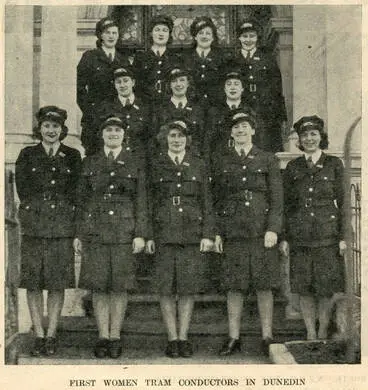

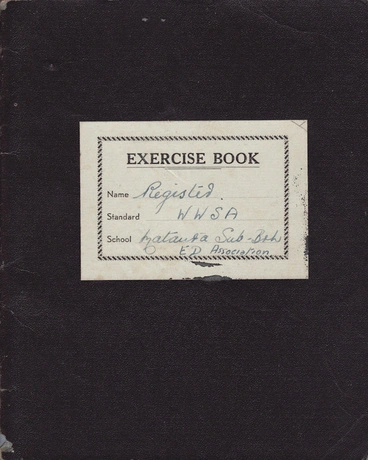
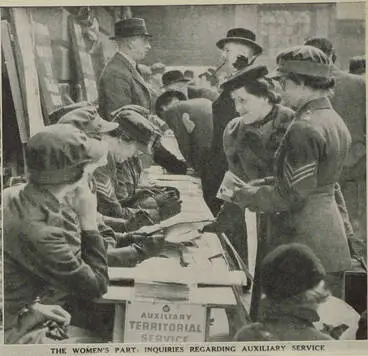
![[A bus load of women factory workers] Image: [A bus load of women factory workers]](https://thumbnailer.digitalnz.org/?resize=770x&src=https%3A%2F%2Fcollection-api.aucklandmuseum.com%2Frecords%2Fimages%2Fmedium%2F568543%2Fe4015f53e95a2b93a94ec4b4e57afd679ce99050.jpg&resize=368%253E)

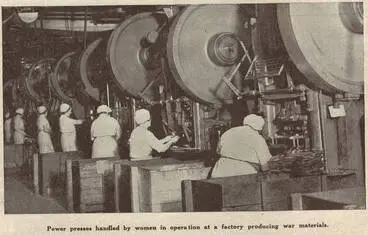
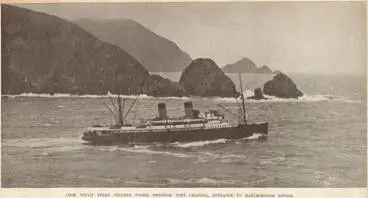
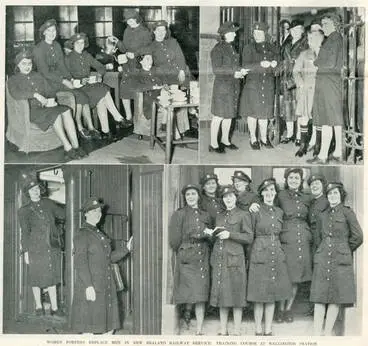


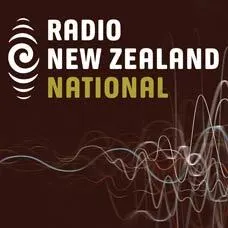
![[Portrait of woman shearing a sheep] Image: [Portrait of woman shearing a sheep]](https://thumbnailer.digitalnz.org/?resize=770x&src=https%3A%2F%2Fcollection-api.aucklandmuseum.com%2Frecords%2Fimages%2Fmedium%2F523100%2F264de18449be980491c1c32d0b84cf6a07e36a53.jpg&resize=368%253E)
![[Four women in paddock holding piles of sheared wool] Image: [Four women in paddock holding piles of sheared wool]](https://thumbnailer.digitalnz.org/?resize=770x&src=https%3A%2F%2Fcollection-api.aucklandmuseum.com%2Frecords%2Fimages%2Fmedium%2F523108%2Fb2ecf3ecef25b40b03ace711d4daffba90cb2023.jpg&resize=368%253E)
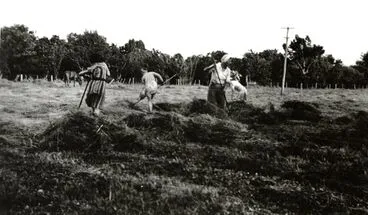
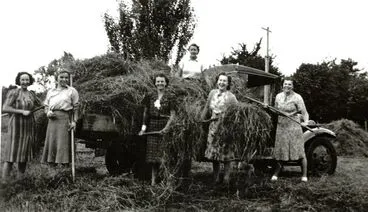
![[Woman riding horse drawn hay baler] Image: [Woman riding horse drawn hay baler]](https://thumbnailer.digitalnz.org/?resize=770x&src=https%3A%2F%2Fcollection-api.aucklandmuseum.com%2Frecords%2Fimages%2Fmedium%2F525792%2F9eb03e3e1f70c2d67b23dc708119685484d594f9.jpg&resize=368%253E)
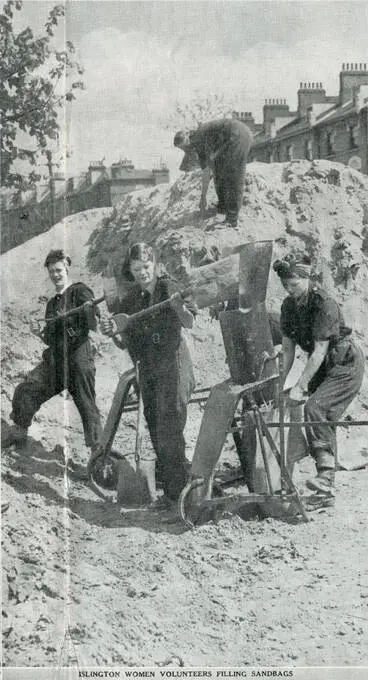
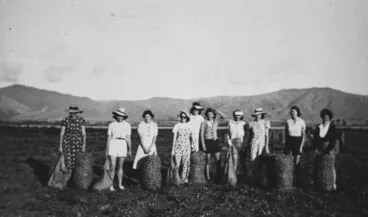
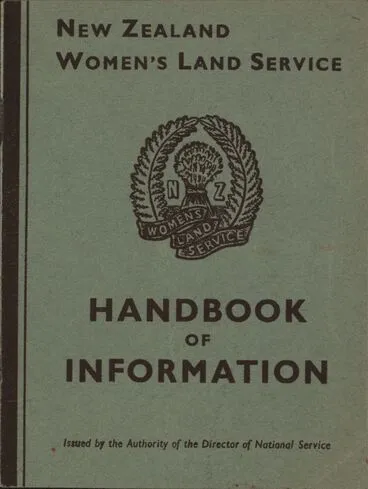
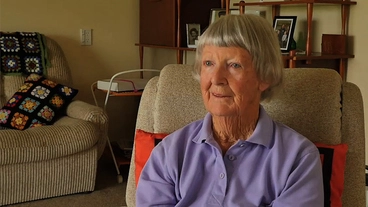
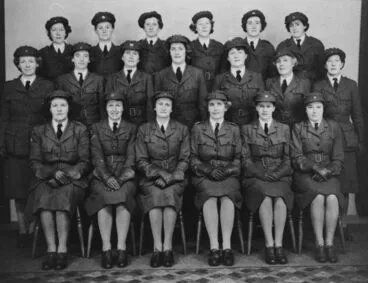
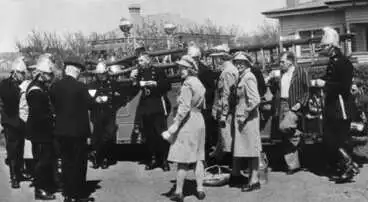
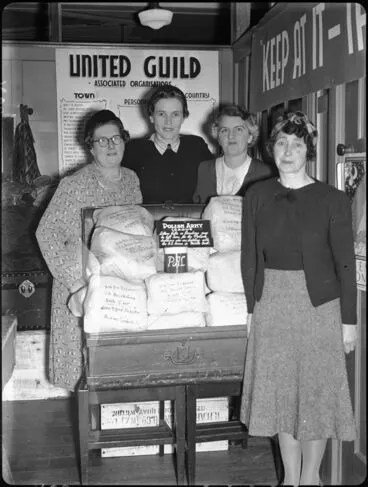
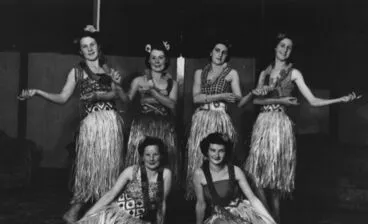
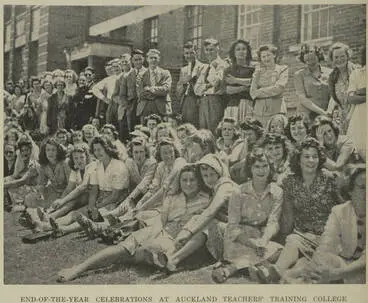
![[Portrait of woman holding baby] Image: [Portrait of woman holding baby]](https://thumbnailer.digitalnz.org/?resize=770x&src=https%3A%2F%2Fcollection-api.aucklandmuseum.com%2Frecords%2Fimages%2Fmedium%2F524888%2F7583962df55298721698f194493dcc2dee28e97c.jpg&resize=368%253E)
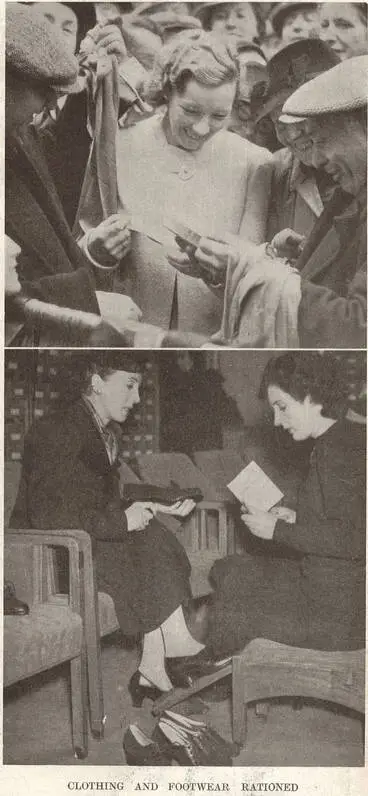
![Ration Card [Clothing] Image: Ration Card [Clothing]](https://thumbnailer.digitalnz.org/?resize=770x&src=https%3A%2F%2Fimages.ehive.com%2Faccounts%2F4033%2Fobjects%2Fimages%2F22568396b5834b8e80616c55cf24c05d_l.jpg&resize=368%253E)

